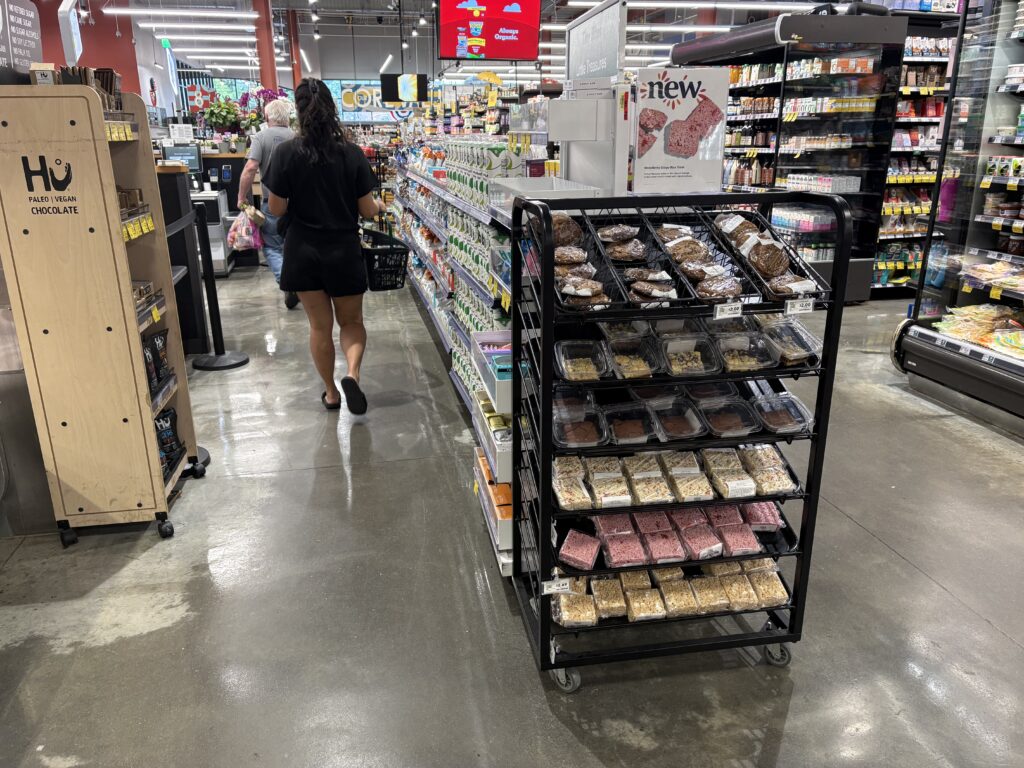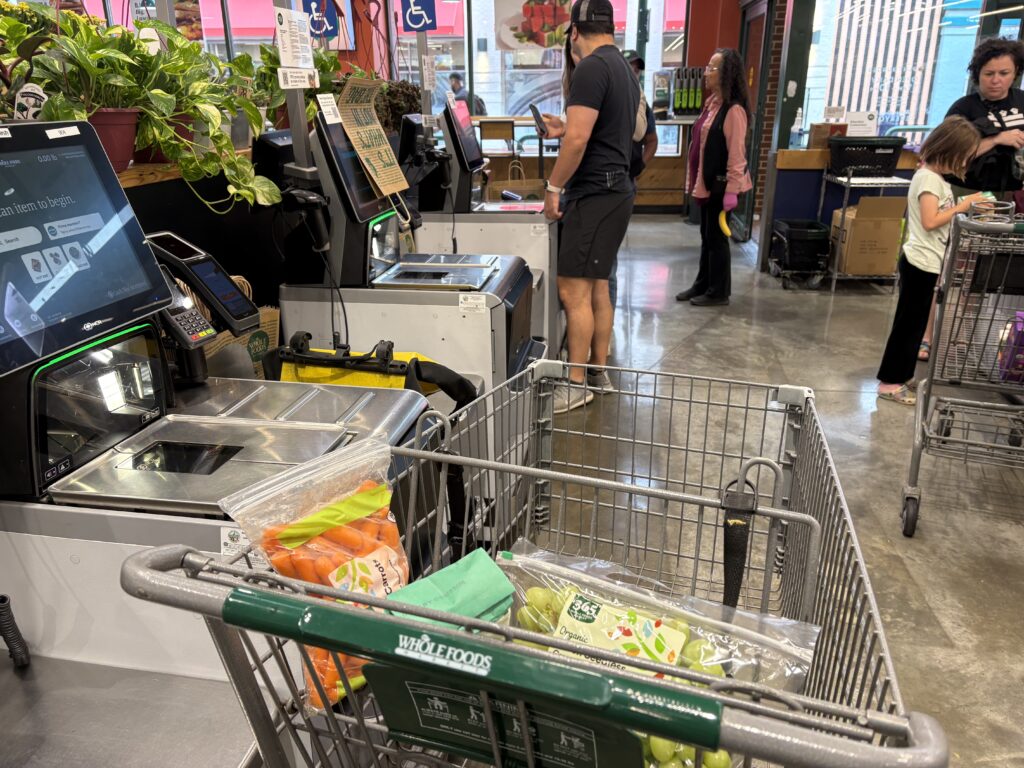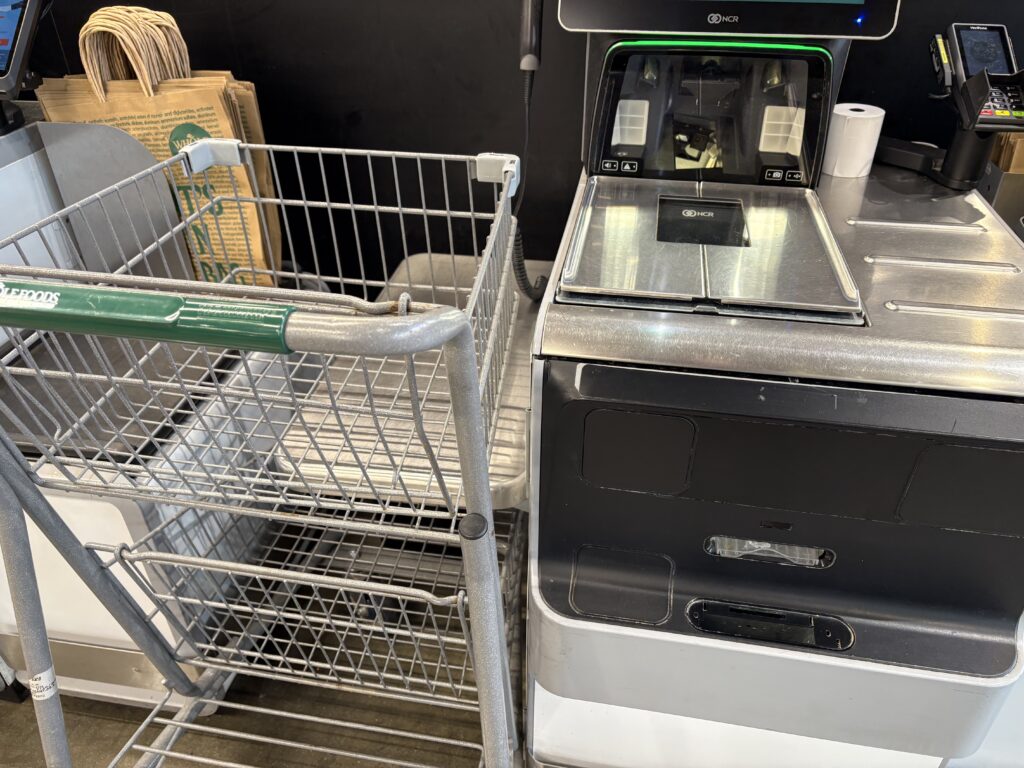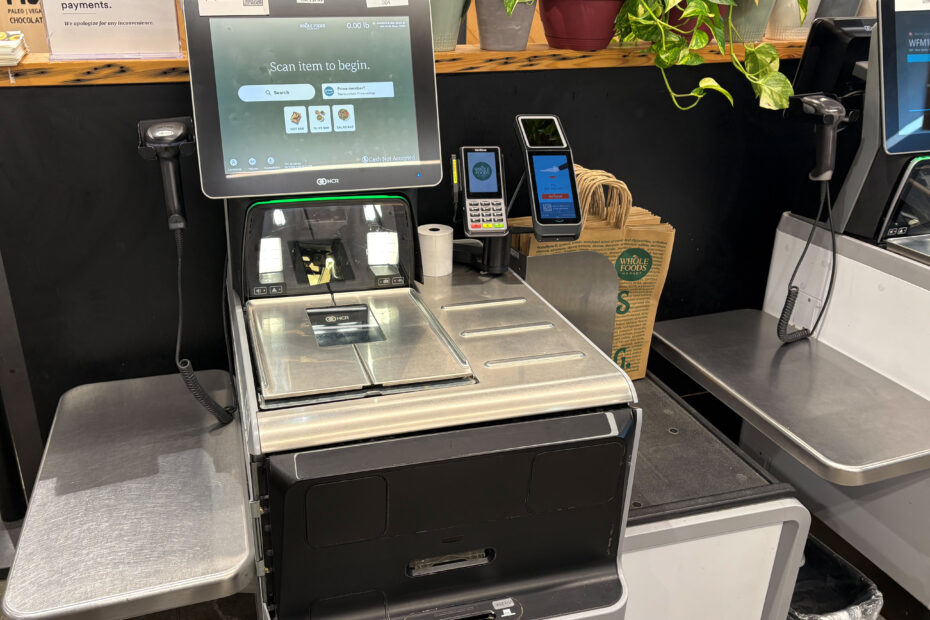Shoppers who are naughtier than nice get an accurate approximation of what awaits them in the afterlife when they use self-checkout at Whole Foods.
Whole Foods is my local stop for delicacies, splurges, and items I can’t buy elsewhere. Whole Foods is too expensive to use as my sole supermarket. Consequently, my Whole Foods trips occur less frequently than my weekly non-Whole Foods supermarket trips and usually consist of ten or fewer items.
I bicycle to the store, so even if I’m only buying a few items, carrying a handbasket in the store is difficult because I’m also carrying a bike bag to hold groceries on the ride home. The only carts readily available are the large, traditional ones, so I usually push these around the crowded store. Whole Foods, at least my local one, has eliminated staffed express checkout lanes and has deep-sixed most of its full-service checkout lanes.
Waiting in the full-service checkout lanes behind people with massively full carts is unacceptable to me. Not only is the wait interminable, but I also must sniff the full-cart-wealthy-shoppers’ stench of entitlement.
So, like obedient cattle, we all shuffle into the corral of self-scanning bays. The alley leading to the self-scanning machines is cluttered with mouth-watering treats designed to break one’s willpower and inflate an already-too-large grocery tab.

Surviving the gauntlet of goodies with my wallet intact, a store employee directs traffic to the next available of nine self-scanning stalls. I wheel my big-ass cart parallel to my assigned machine so that I don’t block the small space between the stalls on the other side. I take out my reusable bags and do my best to unfurl them so they stand up in the grocery loading area next to the scanning machine. Regardless of my ministrations, the bags invariably collapse.
I’m ready to start scanning my items. Unfortunately, the cart blocks the scanning machine. If I push the cart backwards, it encroaches on my neighbor’s space at the adjacent scanning bay. If I push the cart out to make space for me, it impedes other shoppers from getting around me.
I opt to angle the cart diagonally, slightly obstructing traffic flow, and pinning myself between the cart and the scanning machine. This gives me cramped but manageable access to the cart, the machine, and the bagging area.

Despite the small inconvenience of weighing unbarcoded produce and fruit, the self-scanning process is no biggie. Regardless, the ergonomic discomfort of self-scanning in a small area with a big cart gets me every time. It’s an ignominious end to a pleasant shopping trip.
What self-scanning setups get wrong
Self-scanning bays are designed for shoppers with a few items carrying a handbasket. As designed, a shopper places the handbasket on the shelf to the left of the scanning mechanism, scans an item, and places it in a bag to the right of the scanner.
Whole Foods and many other supermarkets have forced shoppers to bring larger baskets into the self-scanning bays by eliminating not just the express full-service lanes, but most of the full-service lanes. Hence, shoppers must deal with large carts, cramped space, and plentiful frustration.
In an astonishing 2023 Lending Tree survey of 2,000 shoppers, 15% confessed to intentionally stealing at the grocery store self-checkout. Perhaps these shoppers justify their theft by claiming they’re doing the store’s work. Possibly, these thieving customers are acting out of frustration.
It’s easy to say that Whole Foods should redesign its scanning bays to accommodate larger loads in larger carts. However, redesigning hardware is expensive and challenging. Fortunately, Whole Foods and other stores that herd shoppers into the self-scanning corral have much easier options.
Easy improvements for self-scanning
Small wheeled carts — buy enough so that anyone who wants one can get one, even at crowded times. These carts are low-tech and shouldn’t break the bank.
My local Whole Foods now only possesses a handful of these carts, and they’re hidden away because even Progressive Whole Foods shoppers steal them. Those in the know must request one from customer service, which is an additional hassle and goes against the principle of self-service. Ironically, these carts that might reduce customer frustration, thereby decreasing theft, are themselves vulnerable to theft and kept under lock and key.

Either by design or by happenstance, the small carts fit into the shelf area to the left of the scanner. The fit isn’t perfect — if one places items in the lower basket, they’re hard to reach when the cart is in the pictured position. However, freeing up space by tucking the cart into the shelf area enables self-scanning to occur without contorting one’s body or impeding other shoppers.
Supply handbasket strollers — like the fold-up strollers that infant car seats snap into. This enables shoppers whose quarry fits into a handbasket to wheel around a small cart instead of lugging a handbasket with heavy items. Ideally, these strollers are designed like the small carts above to fit into the area to the left of the scanners.
A better but costlier option for the grocer
I’m not going to suggest that Whole Foods open more full-service checkout lanes. I’m all about self-scanning. However, the most civilized self-scanning method is to scan while shopping. This way, the shopper scans an item, places it in a bag, and the transaction is complete. Easy peasy.
I don’t need or want a tricked-out cart that detects items I place or remove from the cart. I don’t need an onboard scale — Whole Foods could easily provide communal high-tech scales in the produce area that make identifying and weighing items simple. A handheld scanner would work fine.
Final thoughts
In a thin-margin business like grocery, the massive theft at self-checkout greatly reduces profitability. Stores that opt to continue self-scanning tend to invest heavily in anti-theft technology that may only force criminals to become more creative.
By heeding some simple and inexpensive suggestions to enhance the self-checkout experience, grocery stores like Whole Foods would certainly reduce shopper frustration, which might lead to better-behaved customers.
